Pothos plants are popular today. There are different pothos plant types available. The Pothos plant is considered by several to be an excellent way to start caring for houseplants. This plant is often a simple to worry plant. This trailing vascular plant has pointed, simple green leaves, typically varicoloured with white, yellow, or pale green.
Whereas Pothos likes bright, indirect light-weight, it will thrive in areas that don’t get heaps of daylight or have solely fluorescent lighting.
Pothos plants create an extra addition at your house, restroom workplace. These plants relish a good variety of environments. They are doing well in bright indirect light-weight and low light-weight and may be mature in dry soil or vases of water. They’ll thrive in nutrient-wealthy soil, however, do nearly moreover, in nutrient-poor soil.
Here are Pothos plant types, Let’s see…
1. Golden Pothos
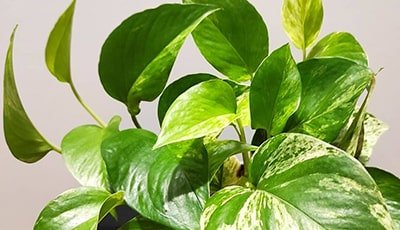 It has the name of being one of the best houseplants to require care of. The common name is Epipremnum aureum. Epipremnum aureum is native to Southeast Asia. This plant can be a species of spermatophyte within the arum family. It options simple mid-green foliage splashed with creamy gold. If you want to grow this extra long then, it provides it several lightweight and heat.
It has the name of being one of the best houseplants to require care of. The common name is Epipremnum aureum. Epipremnum aureum is native to Southeast Asia. This plant can be a species of spermatophyte within the arum family. It options simple mid-green foliage splashed with creamy gold. If you want to grow this extra long then, it provides it several lightweight and heat.
It’s celebrated to overgrow forest floors and tree trunks because of its aerial footage. In sensible indoor conditions, you’ll expect the Epipremnum aureum to path to eight feet long.
- Watering: Water the “Epipremnum aureum” once when the soil become utterly dry. Water it once one week.
- Sunlight: This Pothos likes bright and indirect lightweight. This pothos does not need much sunlight. It is easily grown in-house.
2. Silver Pothos
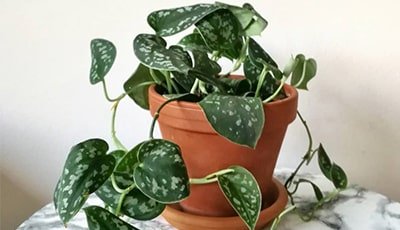 This plant is conjointly referred to as satin pothos. A vascular plant that has dark green leaves with silvery markings, can be heart-formed foliage. The foliage of Silver Pothos is smaller than different varieties. The vascular plant-like quality and the sparkling look of the leaves make it an amazing addition to your indoor jungle.
This plant is conjointly referred to as satin pothos. A vascular plant that has dark green leaves with silvery markings, can be heart-formed foliage. The foliage of Silver Pothos is smaller than different varieties. The vascular plant-like quality and the sparkling look of the leaves make it an amazing addition to your indoor jungle.
The silver vascular plant pothos is native to the tropical rainforests of Asia. This plant alludes to the variegation of silver dabs and blotches on the matte green foliage. The long stems will mature to three-meter long, and that they grow heart-shaped leaves. This pothos plant will build wonderful potted plants with bushy foliage.
- Placement
These pothoses need to grow in a wealthy, well-draining potting combine. The most effective form of potting medium ought to have organic touch hold wet; however, be lightweight enough to freely drains water. The plant’s growth can prevent if it grows in soggy, soggy soil. Just place it in a hanging pot and let the leaves go wherever their hearts need. You ought to combine equal components of potting soil, peat moss, and perlite. Rather than perlite, you’ll add charcoal items or coconut fibber chips to assist increase voidance.
- Sun Light
These plants want lots of bright, indirect daylight to thrive. Place this close to associate east or west-facing window wherever it gets some morning or evening sun. The minimum temperature for silver pothos houseplants is 15°C.
- Watering
In summer, this plant might have watered as usual as double per week or a lot of. In winter, the silver leaf pothos needs less frequent watering. Continuously try and create soil wet.
- Fertilizing
The right quantity of chemicals conjointly helps to stay its gorgeous foliage healthy and spirited. If you notice that the leaf colour begins to fade, confirm and feed it monthly. Stop feeding throughout the winter months and so resume in spring once growth becomes vigorous. It’s necessary to recollect that an excessive amount of chemicals maybe even as dangerous as starving it of nutrients.
3. Cebu Blue Pothos
 This is a lovely variety. Cebu Blue Pothos have arrow-formed blue-green leaves. This could be heart-formed foliage of pothos. Cebu Blue will grow from four to ten feet long. These are low maintenance and simple to grow indoor plants which may do equally within the outside setting. The leaves are sometimes elongated or oval, usually 2 to four inches.
This is a lovely variety. Cebu Blue Pothos have arrow-formed blue-green leaves. This could be heart-formed foliage of pothos. Cebu Blue will grow from four to ten feet long. These are low maintenance and simple to grow indoor plants which may do equally within the outside setting. The leaves are sometimes elongated or oval, usually 2 to four inches.
You’ll expect the leaves to achieve around four inches long. They are doing need time to mature. Therefore you’ll need to be patient. Once mature, Cebu Blue’s leaves take a green hue with sure zig-zag divisions rising to the leaves’ middle section. Cebu Blue is additionally quite a natural climber.
- Watering
The water necessities of the Cebu Blue Plant are medium. Watering the plant once or doubly every week is usually recommended. The frequency ought to be exaggerated on hotter days. Let it dry out a touch bit between watering.
- Sun Light
This is tolerant of normal house temperatures. In this sort of pothos, it is fairly relaxed concerning lighting; therefore, it’ll blithely sleep in a medium-light scenario, except for the lushest and prettiest foliage provides it lots of bright indirect lightweight.
- Fertilizing
The fertilizer added to the soil is typically a mixture of nutrients the plant wants in larger quantities and, therefore, the plant’s nutrients in smaller doses. Check that you dilute the fertilizers with water so the indefinite quantity isn’t too robust. It’s counselled you do not use fertilizers too much throughout the off-season or once the plant isn’t actively growing.
4. N-Joy Pothos
 The scientific name of this plant is “Epipremnum pinnatum N-Joy.” It additionally has varied green leaves that are heavily mottled with white, and therefore the variegation is distinct. It adds beauty and additionally purifies indoor air. However, individual vines will grow quite long but are often cropped in the stem to stay in a compact form.
The scientific name of this plant is “Epipremnum pinnatum N-Joy.” It additionally has varied green leaves that are heavily mottled with white, and therefore the variegation is distinct. It adds beauty and additionally purifies indoor air. However, individual vines will grow quite long but are often cropped in the stem to stay in a compact form.
The Pothos N-joy is one plant that will grow tall, up to ten feet. All plant components contain Ca(calcium) salt crystals, an annoyance to the mouth and gullet. And this can be harmful to cats and dogs.
- Placement
Pothos plants don’t wish to sit in wet soil. Place it during a hanging pot for an additional dramatic feel. The Pothos N-joy grows best in damp soil. Plant pothos during a general well-draining potting combine.
- Sun Light
The Pothos N-joy will thrive in several lighting conditions, together with low light-weight. The proper temperature is 10°C. Moderate indoor light-weight is that the most suggested. Even though it will tolerate low light-weight, it can return at a price because it will probably lose its variegation. You’ll create the white variegation grow and unfold on the foliage if you retain N-Joy Pothos beneath bright light-weight.
- Watering
Water once the higher layer become dry. Watering the plant once or doubly each week is sometimes suggested.
5. Marble Queen Pothos
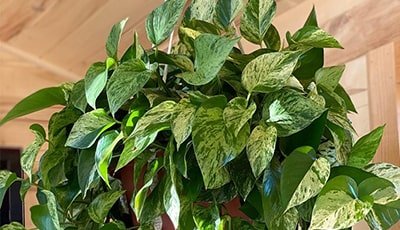
This plant is a well-liked plant within the hardy pothos family. The Marble Queen is straightforward and unexacting.
It options inexperienced unsub divided leaves heavily splashed and streaked with creamy white. The foliage is sometimes similar in size to golden pothos. Marble Queen is also a lot of or less varicoloured, counting on the actual branch it had been propagated from. Place it during an area that gets a medium quantity of natural lightweight, or perhaps in a workplace or restroom that gets low lightweight. Rotate the plant sometimes to encourage even growth.
- Placement
Take soil to glorious drain. “Marble Queen pothos” has to grow in soil that has a nutrient-rich potting combine. Take pothos plant combine could be a mix of equal elements of plant soil, peat moss, and perlite.
- Sun-light
This pothos likes medium to bright indirect daylight. An excessive amount of light-weight can scorch the leaves.
- Watering
Water once the highest many inches of soil has dried out.
6. Neon Pothos
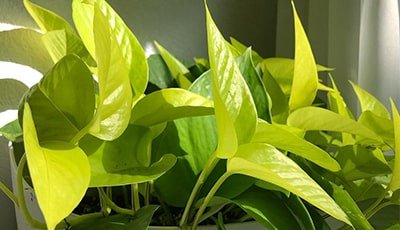 Its scientific name is Epipremnum aureum. Pothos is labeled in and of itself for its bright inexperienced element colour throughout its leaves and stems. Its simple leaves are bright chartreuse or golden yellow with no variegation.
Its scientific name is Epipremnum aureum. Pothos is labeled in and of itself for its bright inexperienced element colour throughout its leaves and stems. Its simple leaves are bright chartreuse or golden yellow with no variegation.
Neon Pothos has all the rugged, sturdy characteristics that plant life lovers expect from Pothos, however, with glowing, neon-green foliage. It’s very easy to grow. Trim plant to take care of the best size and form. Use a balanced liquid fertilizer each month. Element Pothos grows in climatic zone forests, principally in Asia and Australia.
- Watering
Water your element Pothos merely enough to take care of the soil damp, however not soggy. If you grow this in instrumentation, use containers with evidence holes to assist your plant in preventing excess water.
- Sun-light
Neon Pothos will adapt to lower lightweight; however, they prosper in bright, indirect daylight. This verity likes temperatures between seventy and ninety degrees Fahrenheit.
- Placement
Choose a mean, well-draining potting soil for the quickest growth. Pothos likes pH scale between half-dozen. 1 to 6.5. It’s conjointly growing in water; however, it’s not growing well as soil.
- Fertilizing
Fertilize your Pothos each 2-3 months, generally amid the development period. This will maximize the rate of development and guarantee that your plant develops and advances as quickly as possible. House plant fertilizer is the perfect fertilizer.
7. Jessenia Pothos
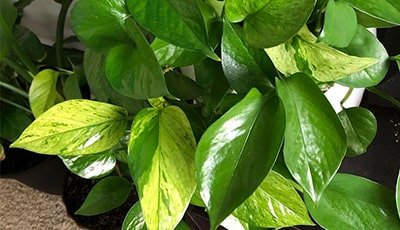 The scientific name is “Epipremnum aureum Jessenia”. This is often an inexperienced, cordate leaf extravagantly marked with chartreuse. Jessenia pothos has inexperienced chordate foliage spiked with greenish-yellow hues. Each leaf of Jessenia pothos can end up completely different than the remainder, similar to Marble Queen.
The scientific name is “Epipremnum aureum Jessenia”. This is often an inexperienced, cordate leaf extravagantly marked with chartreuse. Jessenia pothos has inexperienced chordate foliage spiked with greenish-yellow hues. Each leaf of Jessenia pothos can end up completely different than the remainder, similar to Marble Queen.
The leaves are emerald green with lemon-yellow variegation. Many varied leaves have an edible fat result, and others are nearly pure yellow.
- Watering
Water the Jessenia Pothos when the upper layer becomes completely dry. Water it after 3-4 days.
- Sunlight
Also, another verity Jessenia photos like bright or indirect sunlight.
8. Manjula Pothos
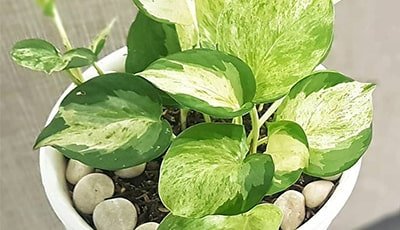 The scientific name of this pothos is “epipremnum aureum Manjula.” The foliage is varicolored with reminder silver, white, cream, and light-weight green. Every leaf is different; several leaves can have giant patches of the inexperienced. It is a good, unsubdivided green leaf. Its leaves have wavy edges. This plant is often the main identification of this.
The scientific name of this pothos is “epipremnum aureum Manjula.” The foliage is varicolored with reminder silver, white, cream, and light-weight green. Every leaf is different; several leaves can have giant patches of the inexperienced. It is a good, unsubdivided green leaf. Its leaves have wavy edges. This plant is often the main identification of this.
A bit recognizes the truth is that the Manjula Pothos could be a selection proprietary and created by the University of Sunshine State.
- Light
This variety like medium or bright lightweight. An excessive amount of sun will scorch her lovely white leaves.
- Watering
Manjula pothos doesn’t want heaps of watering. Keep the soil dumps, however, not wet. Enable the highest of the soil to dry out slightly before watering.
- Fertilizer
This pothos plant wants fertilizer throughout the summer and spring season. Apply fertilizer once 2-3 weeks.
9. Pearls and Jade Pothos
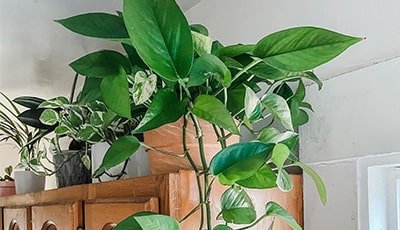 The scientific name of this pothos is “Epipremnum Pearls and Jade.” This plant is an eye-catching selection that sports green leaves varied with white and silvery-gray. The Pearls and Jade Pothos may be versatile and one amongst the best to worry about houseplants. Though it’s native to Polynesia, pothos may be found in several tropical environments. The variegation tends to look a lot on the foliage’s sides instead of the center.
The scientific name of this pothos is “Epipremnum Pearls and Jade.” This plant is an eye-catching selection that sports green leaves varied with white and silvery-gray. The Pearls and Jade Pothos may be versatile and one amongst the best to worry about houseplants. Though it’s native to Polynesia, pothos may be found in several tropical environments. The variegation tends to look a lot on the foliage’s sides instead of the center.
The white sections of the foliage are usually patterned with green and silvery gray tones. Pearls and Jade pothos tend to possess smaller leaves than many other varieties and tend to grow slowly.
- Light
This plant may be okay in shade or sun, but it will best in partial shade conditions year-round. An excessive amount of lightweight will burn the leaves or cause them to lose their marbleized quality.
- Watering
It’s best to water once the soil feels dry, concerning once every week. It may be a lot of or less though’ betting on your area’s wetness and warmth.
Have some questions or suggestions? Use our comments section on this blog! You can feel free to leave a comment or two down below, and we’ll get back to you as soon as possible!
We love reading your messages……

